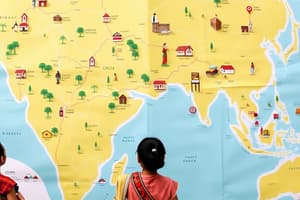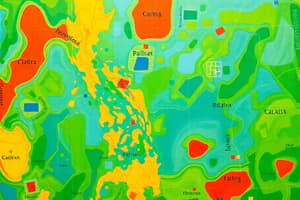Podcast
Questions and Answers
A Memorandum of Understanding between the NCCA and the LGU is established after the cultural mapping project begins.
A Memorandum of Understanding between the NCCA and the LGU is established after the cultural mapping project begins.
False (B)
The training of local mappers includes modules on Intangible Heritage and Understanding LGU Programs.
The training of local mappers includes modules on Intangible Heritage and Understanding LGU Programs.
True (A)
Data gathering by mappers lasts approximately one to two months.
Data gathering by mappers lasts approximately one to two months.
False (B)
Regular monitoring meetings for mappers are scheduled at least once a month.
Regular monitoring meetings for mappers are scheduled at least once a month.
Quality collaboration among multi-stakeholders is not crucial for a successful cultural mapping project.
Quality collaboration among multi-stakeholders is not crucial for a successful cultural mapping project.
Cultural heritage includes only tangible properties such as buildings and artifacts.
Cultural heritage includes only tangible properties such as buildings and artifacts.
Intangible cultural heritage includes languages and performing arts.
Intangible cultural heritage includes languages and performing arts.
Tangible cultural property does not have to be of Philippine origin to be considered significant.
Tangible cultural property does not have to be of Philippine origin to be considered significant.
Important cultural property is solely determined by local community consensus.
Important cultural property is solely determined by local community consensus.
Nationally significant cultural properties are evaluated based on their aesthetic and historical values.
Nationally significant cultural properties are evaluated based on their aesthetic and historical values.
Cultural property includes only those that are publicly owned.
Cultural property includes only those that are publicly owned.
Intangible cultural property can refer to knowledge and skills relevant to traditional practices.
Intangible cultural property can refer to knowledge and skills relevant to traditional practices.
Significance assessment focuses solely on the provenance of a cultural item.
Significance assessment focuses solely on the provenance of a cultural item.
Integrity refers to how well a cultural item is preserved and whether it is intact.
Integrity refers to how well a cultural item is preserved and whether it is intact.
The rarity of a cultural property means it is a commonly seen example of its type.
The rarity of a cultural property means it is a commonly seen example of its type.
Assessment of significance is a static process that does not require revision over time.
Assessment of significance is a static process that does not require revision over time.
Cultural mapping teams can use specific questions to guide the assessment of cultural properties.
Cultural mapping teams can use specific questions to guide the assessment of cultural properties.
A cultural property's representativeness is assessed by whether it perfectly reflects a specific class or type.
A cultural property's representativeness is assessed by whether it perfectly reflects a specific class or type.
Ownership and usage history of a cultural property are considered irrelevant in its significance assessment.
Ownership and usage history of a cultural property are considered irrelevant in its significance assessment.
The Philippine Registry of Cultural Properties (PRECUP) can include items that have undergone significance assessment.
The Philippine Registry of Cultural Properties (PRECUP) can include items that have undergone significance assessment.
Preparing a conservation management plan does not relate to the significance assessment of cultural properties.
Preparing a conservation management plan does not relate to the significance assessment of cultural properties.
Significance assessment allows heritage managers to make informed decisions about cultural properties.
Significance assessment allows heritage managers to make informed decisions about cultural properties.
The National Museum of the Philippines focuses solely on artistic heritage.
The National Museum of the Philippines focuses solely on artistic heritage.
The National Library of the Philippines aims to preserve all printed materials related to Filipiniana.
The National Library of the Philippines aims to preserve all printed materials related to Filipiniana.
The Cultural Center of the Philippines is tasked with promoting excellence exclusively in visual arts.
The Cultural Center of the Philippines is tasked with promoting excellence exclusively in visual arts.
The National Archives of the Philippines is primarily located in Pasay City.
The National Archives of the Philippines is primarily located in Pasay City.
The National Museum has a goal to guide in the preservation of the nation's cultural heritage.
The National Museum has a goal to guide in the preservation of the nation's cultural heritage.
The National Library of the Philippines provides bibliographic services only to international users.
The National Library of the Philippines provides bibliographic services only to international users.
The National Museum focuses on technical knowledge dissemination in fields such as geology and zoology.
The National Museum focuses on technical knowledge dissemination in fields such as geology and zoology.
The National Library of the Philippines is the premier repository of digital materials.
The National Library of the Philippines is the premier repository of digital materials.
The Cultural Center of the Philippines aims to elevate standards among cultural workers and audiences.
The Cultural Center of the Philippines aims to elevate standards among cultural workers and audiences.
The National Library of the Philippines is responsible for organizing and supervising public libraries across the country.
The National Library of the Philippines is responsible for organizing and supervising public libraries across the country.
The Filipino First Policy is aimed at ensuring the preservation of the national patrimony in the hands of qualified individuals.
The Filipino First Policy is aimed at ensuring the preservation of the national patrimony in the hands of qualified individuals.
The National Museum is primarily responsible for the regulation of activities related to historical structures.
The National Museum is primarily responsible for the regulation of activities related to historical structures.
R.A. No. 10066 mandates cultural agencies to take specific actions related to the conservation of cultural properties.
R.A. No. 10066 mandates cultural agencies to take specific actions related to the conservation of cultural properties.
The National Commission for Culture and the Arts has no regulatory power regarding national cultural heritage.
The National Commission for Culture and the Arts has no regulatory power regarding national cultural heritage.
The National Historical Commission of the Philippines is based on T.M. Kalaw Street, Ermita, Manila.
The National Historical Commission of the Philippines is based on T.M. Kalaw Street, Ermita, Manila.
Presidential Decree Nos. 260 and 374 are among the regulations that the National Museum must implement.
Presidential Decree Nos. 260 and 374 are among the regulations that the National Museum must implement.
The Komisyon ng Wikang Filipino is responsible for regulating the preservation of historical properties.
The Komisyon ng Wikang Filipino is responsible for regulating the preservation of historical properties.
The National Museum is tasked with the preservation and reconstruction of the nation’s artistic heritage.
The National Museum is tasked with the preservation and reconstruction of the nation’s artistic heritage.
The declaration of historic sites is solely within the purview of the National Museum.
The declaration of historic sites is solely within the purview of the National Museum.
Flashcards
Cultural Heritage
Cultural Heritage
All cultural properties, both tangible and intangible, that have been preserved and developed over time and passed down to future generations.
Cultural Property
Cultural Property
Anything created by humans that reveals a nation's identity, including places of worship, schools, historical artifacts, and intangible practices.
Tangible Cultural Property
Tangible Cultural Property
Physical cultural properties with historical, artistic, or scientific value, such as antiques, buildings, or natural history specimens.
Intangible Cultural Property
Intangible Cultural Property
Signup and view all the flashcards
Intangible Cultural Heritage
Intangible Cultural Heritage
Signup and view all the flashcards
Nationally Significant
Nationally Significant
Signup and view all the flashcards
Important Cultural Property
Important Cultural Property
Signup and view all the flashcards
Filipino First Policy
Filipino First Policy
Signup and view all the flashcards
Cultural Agencies
Cultural Agencies
Signup and view all the flashcards
NCCA's Role
NCCA's Role
Signup and view all the flashcards
National Museum's Role
National Museum's Role
Signup and view all the flashcards
NHCP's Role
NHCP's Role
Signup and view all the flashcards
What does NHCP stand for?
What does NHCP stand for?
Signup and view all the flashcards
What does NCCA stand for?
What does NCCA stand for?
Signup and view all the flashcards
What does NM stand for?
What does NM stand for?
Signup and view all the flashcards
What is the purpose of R.A. No. 10066?
What is the purpose of R.A. No. 10066?
Signup and view all the flashcards
What is the primary goal of the social preparation phase in cultural mapping?
What is the primary goal of the social preparation phase in cultural mapping?
Signup and view all the flashcards
What are some key activities during the training phase?
What are some key activities during the training phase?
Signup and view all the flashcards
Data gathering phase
Data gathering phase
Signup and view all the flashcards
What's the purpose of the data validation and reporting phase?
What's the purpose of the data validation and reporting phase?
Signup and view all the flashcards
Why is partnership crucial for cultural mapping?
Why is partnership crucial for cultural mapping?
Signup and view all the flashcards
Provenance
Provenance
Signup and view all the flashcards
Representativeness
Representativeness
Signup and view all the flashcards
Integrity
Integrity
Signup and view all the flashcards
Rarity
Rarity
Signup and view all the flashcards
Assess Significance
Assess Significance
Signup and view all the flashcards
Cultural Mapping
Cultural Mapping
Signup and view all the flashcards
Cultural Profile
Cultural Profile
Signup and view all the flashcards
Conservation Management Plan
Conservation Management Plan
Signup and view all the flashcards
PRECUP
PRECUP
Signup and view all the flashcards
Local Environmental Plan
Local Environmental Plan
Signup and view all the flashcards
National Museum of the Philippines
National Museum of the Philippines
Signup and view all the flashcards
National Library of the Philippines
National Library of the Philippines
Signup and view all the flashcards
National Library's Objectives
National Library's Objectives
Signup and view all the flashcards
Cultural Center of the Philippines
Cultural Center of the Philippines
Signup and view all the flashcards
Cultural Center's Mission
Cultural Center's Mission
Signup and view all the flashcards
National Archives of the Philippines
National Archives of the Philippines
Signup and view all the flashcards
Preservation of Cultural Heritage
Preservation of Cultural Heritage
Signup and view all the flashcards
Filipiniana Materials
Filipiniana Materials
Signup and view all the flashcards
National Heritage Institutions
National Heritage Institutions
Signup and view all the flashcards
Study Notes
Cultural Heritage in the Philippines
- The 1987 Philippine Constitution commits the state to promoting, enriching, and conserving artistic and historical wealth.
- Cultural properties are under state protection and the state can regulate their disposal.
- Republic Act No. 10066 (National Cultural Heritage Act of 2009) details a vision for cultural heritage that includes harmony between the past and present, a holistic approach to conservation, and stewardship for future generations.
- Objectives of the act include protecting, preserving, conserving and promoting cultural heritage, establishing and strengthening cultural institutions, and supporting cultural workers in their development and well-being.
- The 1987 Constitution, under Article XIV on "Arts and Culture," declares the State's commitment to foster, preserve, enrich and encourage Filipino national culture based on unity in diversity.
- The law defines cultural heritage, and cultural properties.
- Tangible cultural properties include items with historical, archival, archeological, artistic, architectural, and natural history value.
- Intangible cultural properties encompass practices, representations, knowledge, expressions, skills, skills and associated instruments, artifacts, and objects demonstrating cultural heritage, oral traditions, languages, performing arts, social practices, festivals, knowledge of nature, and traditional crafts.
- National Cultural treasures are unique and significant cultural properties.
- Historical shrines are revered for their historical significance/association.
- National cultural landmarks are associated with events or achievements in Philippine History.
- Natural properties of cultural significance are areas with outstanding ecosystems.
- Important cultural property is that which demonstrates exceptional cultural, artistic and/or historical significance.
- Heritage zones are historical, anthropological, archaeological, artistic, and geographical areas significant to the country.
- The World Heritage Site recognition is given by the UNESCO (United Nations Educational, Scientific, and Cultural Organization).
- Built Heritage refers to architecture and engineering structures with historical and/or cultural significance.
- Conservation of cultural property involves various processes and measures to maintain cultural significance.
- The National Commission for Culture and the Arts (NCCA) and other national agencies have roles and responsibilities related to heritage conservation.
- National laws protect cultural heritage through Acts like Republic Act 10066 and Republic Act 4846.
- Also, some international declarations, conventions, and agreements concerning heritage protection are relevant.
Cultural Mapping
- Cultural mapping is a participatory approach to identify, record, and use cultural resources to build communities.
- The mapping process involves scoping, negotiations with partners, training, data gathering, validation, and finalizing the local culture profile.
- The phases of cultural mapping include scoping and negotiations, social preparation, training of local teams, data gathering, and data validation.
- Data fields needed in cultural mapping include backgrounds like name, location, and type/nature of resources, description, dimensions, ownership/jurisdiction, significance, conservation, and references.
- A primary output of cultural mapping is a local culture profile (baseline data about cultural statistics).
- Cultural mapping is essential for local governance, research, conservation, and community development.
- Various stakeholders (local government units, community members, cultural institutions, and experts) play key roles in the project.
Heritage Domains
- Cultural properties include elements that demonstrate human creativity, churches, mosques, places of worship, schools, natural history specimens, and sites.
- Tangible and intangible cultural properties are valued.
- Important cultural properties have exceptional significance.
- Heritage domains have differing levels of significance, including local, regional, national, and international.
Assessment of Significance
- Assessment of cultural significance employs criteria like provenance, representativeness, rarity, integrity, and relationship with local history.
Studying That Suits You
Use AI to generate personalized quizzes and flashcards to suit your learning preferences.




